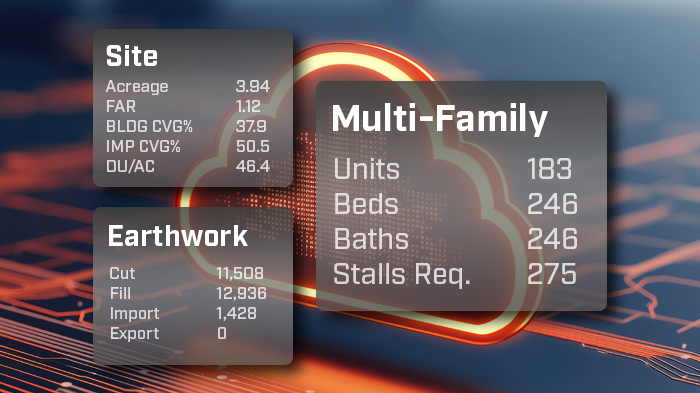
What is the typical process for site selection? Typically it is a very bottom-up approach. Talking to brokers, driving around looking, or hearing about one at a happy hour. With the power of public records and massive amounts of data, we can look to software for a different route.
What is a top-down approach to site selection?
I am going to need to know two things, minimally, in order to run an economic model on new potential sites. First, where it is, and second, what kind of building (if any) does it have on it. For this workflow I will use two different platforms.
- Site Identify is a tool to do massive search functions on parcel + assemblage data.
- TestFit is a tool to solve site plans quickly.
For this search I have a specific building criteria in mind:
- Building Type: Multifamily (TestFit specializes in this)
- Construction Type: 4 Story Stick (type v) wrapping a garage (1.5 stalls per unit)
- Total Units: Roughly 270 (900 sf avg)
- Roughly a 60 DU/AC density
Some math: 270 units / 60 units per acre = 4.5 acres zoned for multifamily. This helps me to target the minimum and maximum sized site for development.
Taking this criteria, I can program the search into Site Identify:
- Market: San Antonio (inside loop 410)
- Acreage: 4-5 Acres
- Existing Improvement Age: Built before 1968 (50 years)
This search yielded twelve possibilities, the first four are a no-go, the middle four are maybes, and the final four are pretty good: link to mapThe two most promising of these twelve are definitely 421 Roosevelt and 815 E. Ashby. I am going to plug them into Residential Engine to get a site plan to work with.421 Roosevelt easily yields more than 275 units in a four level wrap.815 E Ashby Knocks it out of the park at first glance, but it has a freeway lining its north side:I am going to flip to a two tray garage and try to turn my back on 281 as much as possible. Here are the results:I think the second option is much more realistic for the location. Here is a video of how this workflow looked in Residential Engine:
To Plug into the Pro-Forma:
421 Roosevelt: 281 Units / 887 Average Unit Size on 4.76 Acres815 E Ashby: 273 Units / 880 Average Unit Size on 5.02 Acres
Final Thoughts
While this is not an ordinary workflow, this could be the blueprint for the future of development. Instead of waiting for something to come along, parcels could be targeted during a down-cycle and relationships made with land-owners, and then executed during the next cycle.Just to recap: We looked at San Antonio (inside loop 410) and found 12 parcels (not assemblages) that could be developed into a 4 level wrap apartment community. We culled out sites that were not very desirable and landed on two to test for a site plan. Residential Engine gave us a few options to consider with our financial model.A special thanks to Site Identify for allowing me to test their awesome online software! If you are interested in it contact David Morin.







